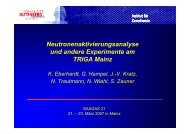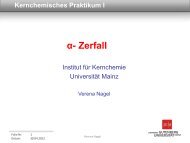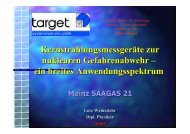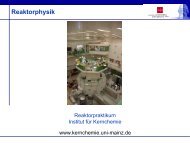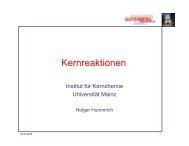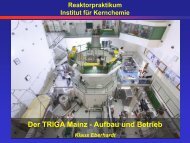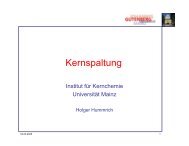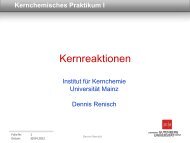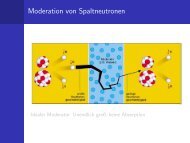jahresbericht 2007 - Institut für Kernchemie - Johannes Gutenberg ...
jahresbericht 2007 - Institut für Kernchemie - Johannes Gutenberg ...
jahresbericht 2007 - Institut für Kernchemie - Johannes Gutenberg ...
Create successful ePaper yourself
Turn your PDF publications into a flip-book with our unique Google optimized e-Paper software.
cantly lower pressure in the 0.2 to 0.5 mbar range gives<br />
optimum results in the SIM. A more detailed investigation<br />
of the pressure dependence is under way.<br />
One of the most interesting but least understood parameter<br />
in the operation of gas-filled separators is the gas<br />
filling. In addition to He as our standard gas, we did first<br />
test experiments with H 2 , N 2 , and mixtures of He and N 2 .<br />
In the 40 Ar + nat Lu reaction we probed the influence of<br />
small amounts of N 2 in He on the magnetic rigidity and<br />
tested the pressure dependence in pure N 2 . From the 48 Ca<br />
+ 208 Pb reaction clean α-spectra of 254 No and its daughter<br />
250 Fm were measured in the HTM with He and H 2 fillings.<br />
Figure 1 shows an example obtained with 1.5 mbar H 2 .<br />
Counts / 10 keV<br />
140 254 No<br />
120<br />
100<br />
80<br />
60<br />
40<br />
20<br />
250 Fm<br />
0<br />
1 2 3 4 5 6 7 8 9 10<br />
E / MeV<br />
Figure 1: α-spectrum of 254 No separated in a 1.5-mbar H 2<br />
gas filling of TASCA. 250 Fm is the daughter nucleus.<br />
The 22 Ne( 181 Ta,xn) 198m,199 Bi reaction was used to check<br />
the calculated transmission [7] in the HTM and in the<br />
SIM. 198m,199 Bi were collected in Al catcher foils directly<br />
behind the target (used as the 100% reference value) and<br />
in the focal plane. Subsequent γ-ray spectroscopic measurements<br />
of these foils allowed determining the transmission<br />
and, from a measurement of segments, the spatial<br />
product distribution in the focal plane. Very good agreement<br />
was found between theoretically calculated transmissions<br />
and distributions and the measured ones.<br />
Target development and testing with 40 Ar beams of up<br />
to 2 µA(particle) continued and concentrated on metallic<br />
Th and U targets on 2 µm Ti backings. In addition, large<br />
varieties of 144 Sm, 179 Au and 206,208 Pb targets were prepared<br />
and used for intense parameter studies at TASCA.<br />
Preparations towards new transuranium targets were concentrating<br />
on 244 Pu. In this ongoing program, considerable<br />
progress has been achieved recently.<br />
Commissioning experiments for the RTCs [8], which<br />
were built for both two ion-optical modes, focused on<br />
finding best conditions for transporting preseparated nuclides<br />
to sites where chemistry experiments are envisaged<br />
to take place, i.e., a position inside X8 as well as in the<br />
nearby radiochemistry laboratory. Suitable nuclides were<br />
produced with 40 Ar beams, e.g., α-decaying 25-s 188 Pb<br />
and 4-s 245 Fm as well as longer-lived Os, Hg, and Pb isotopes<br />
that were identified with γ-ray spectroscopy.<br />
Yields of preseparated Pb isotopes, transported with a<br />
He/KCl gas-jet to the chemistry laboratory, were measured<br />
as a function of parameters like (i) the thickness of<br />
degrader foils installed in front of the RTC window, (ii)<br />
the RTC depth, (iii) the pressure inside the RTC, and (iv)<br />
the gas-flow rate. Maximum yields of about 65% were<br />
obtained for transport to the radiochemistry laboratory<br />
through a 10-m long PE capillary at He flow rates of 2.5<br />
L/min at a pressure of 1.2 bar in the RTC.<br />
The product range in the He-filled RTC was measured<br />
by inserting catcher foils to positions with different distances<br />
from the RTC window. The measured ranges in He<br />
turned out to be larger than the values predicted by SRIM<br />
calculations, even though the energy loss in the Mylar<br />
degrader foil and window agrees well with such calculations.<br />
This was confirmed in measurements of EVRs in<br />
the FPD after passing through degrader foils.<br />
Preseparated 188 Pb was measured after transport into<br />
ROMA [9]. Clean α-spectra and high yields allowed determining<br />
the half-life of (23.4±0.4) s with better precision<br />
than the literature value of (24.2±1.0) [10]. Furthermore<br />
experiments were performed where 245 Fm was<br />
transported into ROMA; see Figure 2. They prove that the<br />
TASCA-RTC system is ready for experiments with SHE.<br />
Smoothed counts / 60 keV<br />
20<br />
15<br />
10<br />
5<br />
241 Cf<br />
245 Es?<br />
214<br />
Po?<br />
245 Fm<br />
Counts / 5 s<br />
0<br />
6.0 6.5 7.0 7.5 8.0 8.5 9.0 9.5 10.0 10.5 11.0<br />
10<br />
E / MeV<br />
1<br />
T 1/2<br />
=(4.6±0.4) s<br />
0 5 10 15 20 25 30<br />
t / s<br />
Figure 2: α-spectrum of 245 Fm. The insert shows the decay<br />
curve for α-particles with 8.05 MeV < E α < 8.25 MeV.<br />
References<br />
[1] M. Schädel et al., GSI Sci. Rep. 2005, GSI Report<br />
2006-1, 2006, p. 262, and http://www.gsi.de/TASCA<br />
[2] A. Semchenkov et al., GSI Sci. Rep. 2004, GSI Report<br />
2005-1, 2005, p. 332.<br />
[3] M. Schädel, Eur. Phys. J. D 45 (<strong>2007</strong>) 67.<br />
[4] A. Semchenkov et al., Proceedings EMIS '07, Nucl.<br />
Instr. Meth. B, submitted.<br />
[5] E. Jäger et al., GSI Sci. Rep. 2005, GSI Report 2006-<br />
1, 2006, p. 263.<br />
[6] J. Even et al., this report.<br />
[7] K.E. Gregorich et al., GSI Sci. Rep. 2006, GSI Report<br />
<strong>2007</strong>-1, <strong>2007</strong>, p. 144.<br />
[8] Ch.E. Düllmann et al., GSI Sci. Rep. 2006, GSI Report<br />
<strong>2007</strong>-1, <strong>2007</strong>, p. 146.<br />
[9] K. Sümmerer et al., GSI Sci. Rep. 1983, GSI Report<br />
84-1, 1984, p. 246.<br />
[10] R.B. Firestone and V.S. Shirley (Eds)., Table of Isotopes,<br />
8 th edition, Vol. II<br />
- A10.2 -



